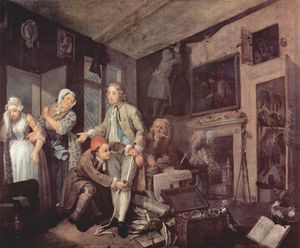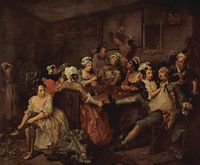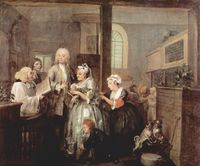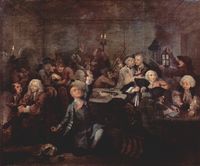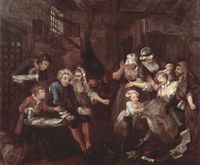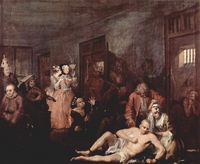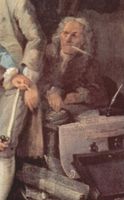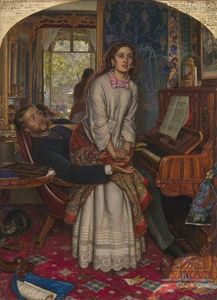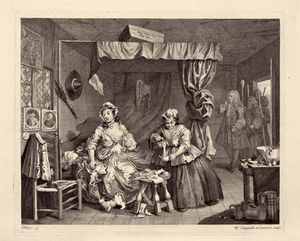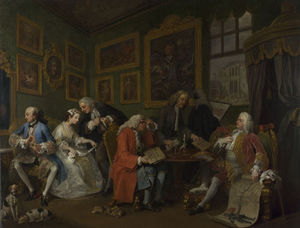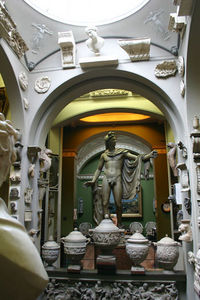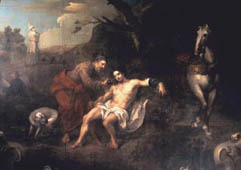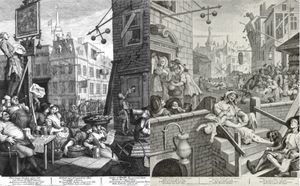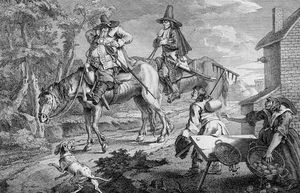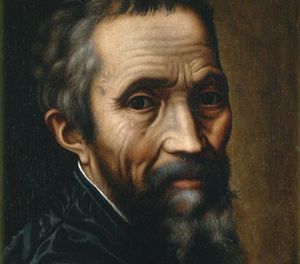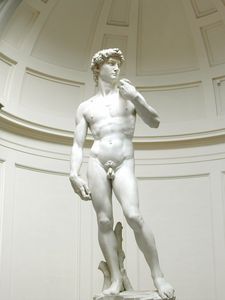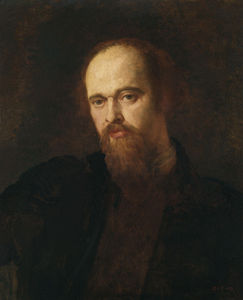A Rake's Progress
- Date of Creation:
- 1733
- Height (cm):
- 62.50
- Length (cm):
- 75.00
- Medium:
- Oil
- Support:
- Canvas
- Subject:
- Scenery
- Art Movement:
- Rococo
- Created by:
- Current Location:
- London, United Kingdom
- Displayed at:
- Sir John Soane's Museum
- Owner:
- Sir John Soane's Museum
A Rake's Progress Story / Theme
In A Rake's Progress Hogarth depicts the story of Tom Rakewell, a young man who inherits money from his late father and squanders it on expensive clothes, prostitutes and gambling.
Although Tom is not portrayed as an evil character, he is certainly out of his depth, thrown into a life trying to emulate the aristocracy without the knowledge or the funds to sustain it.
Over eight plates Hogarth illustrates the life of Tom Rakewell; after losing his father and his fortune, he indulging in orgies and drunkenly cavorting with prostitutes. Having squandered his fortune Tom is forced to marry an older, wealthy woman in order to pay his debts. However, his attention is directed at the maid rather than his new wife.
He then loses his second fortune and is sent to the debtor's jail and eventually ends up in the notorious Bedlam Hospital for the insane which is full of a range of characters. Tom is comforted by the ever present Sarah Young, the maid he so greatly admires.
A Rake's Progress Inspirations for the Work
Debtors' prison:
Hogarth's father was detained in Fleet debtor's prison for most of his childhood. Although the artist never talked about this in any of his biographical writings it must have had a profound effect on him. Certainly the conditions which Tom Rakewell found himself in must have been very similar to that of Hogarth's father.
Bedlam:
Bedlam was an infamous mental hospital in the 18th century and was open for viewing by the public for a small fee. Run by the infamous Baron Henry Brougham, there were many accounts of inmates being badly treated and abused. Hogarth's use of this setting reflects the 18th century view that madness was a result of moral weakness.
Local scandals:
The social scandals of the day can only have been inspirations for this satirical attack on the upper classes. Wealthy young men were often seen frequenting the drinking holes and brothels of London. Gambling and drinking were so popular that it's very likely Hogarth had read about or knew men in similar positions.
It was certainly very common for a poor young man to marry an older woman for her money.
Hogarth's Moral Values:
In all of Hogarth's paintings his strong moral code is very evident and he uses his work almost as an excuse to preach to society. A Presbyterian upbringing and strong moral standing meant that Hogarth was keen to use art as a way to shock the general public into action, concerning the vices and addictions that he felt were ruining English society.
A Rake's Progress Analysis
Composition:
In A Rake's Progress Hogarth uses his theories on the analysis of beauty by including numerous characters within the scene and using symbolism to create an overcrowded composition in which the narrative is very clear.
The artist also uses his serpentine curves and his lighting techniques highlight various characters and aspects, while lesser characters are in the shadowy parts of the painting.
Painting style:
These works were later made into engravings and became publically available, being displayed in public buildings as well as private houses. Hogarth's style of painting is reminiscent to that of the Rococo fashion where loose lines and free hand movement dominate the work.
Color palette:
A rich color palette is also used in bright and muted tones as Hogarth makes red his primary color to accentuate the characters in the smoky tavern and dingy buildings.
He uses many brown tones in these works and overall warm colors dominate, with numerous chiaroscuro techniques.
A Rake's Progress Critical Reception
As with Hogarth's other moral and satirical works during this period, A Rake's Progress was generally well received by the public and critics alike. It's difficult to establish how many copies were sold due to the lack of records but the painting's good reputation and influence on the theatre and publications since then mean it's easy to assume that it was a success.
Modern Reception:
David Bindman:
In his book 'Hogarth and His times: Serious Comedy' Bindman says: 'The reputation of William Hogarth (1697-1764) rests largely on his pictorial stories, a series of engravings that he called 'modern Moral Subjects,'.
Brian Sewell:
"... we grapple with the spirit of a man whose greatest innovation in the history of British art was immediate communication, telling and direct, with those who had in his day, and still in ours, no experience of art as art."
19th Century Reception:
The Pre-Raphaelite Brotherhood of the 19th century followed Hogarth's work and used many of his techniques and methods to bring their own work into the commercial sphere. These techniques included;
A strong narrative element
Attacks on aristocracy and the impression of strong middle-class values
The use of animals as symbolic foils for the main action in the scene
The use of such images as the basis for engravings which were then widely distributed
Hogarth's moral works certainly appealed to artists such as William Holman Hunt who admired his moral standing and portrayed similar themes in his paintings.
A Rake's Progress Related Paintings
A Rake's Progress Locations Through Time - Notable Sales
There were many copies of the prints of A Rake's Progress and although many of them have been lost or destroyed, numerous copies still exist in private collections and galleries.
In an advertisement published in 1734 Hogarth invited anyone wishing to buy prints of A Rake's Progress to visit his studio in Leicester Fields to see the original paintings. The original paintings for A Rake's Progress were sold to the Soane Museum in London in 1802 for 570 guineas.
They were originally hung at the Soane family's country villa, Pitzhanger Manor, Ealing, but were moved back to London in 1810.
A Rake's Progress Artist
Hogarth art mainly focused on the moral codes which he and most of society recognized. Codes that were being flouted by people from all walks of life on a regular basis and the artist felt should be brought back to the attention of ordinary people.
Hogarth produced A Rake's Progress in 1735 and the series was to be one of Hogarth first successes in the new genre of modern morality paintings. This set was created as male alternative to 'A Harlot's Progress' which Hogarth created a few years previously.
It shows the deterioration of mankind when moral codes are abandoned and people give in to consumerism, a major problem for the upper classes of the 18th century.
The artist was heavily influenced by 18th century life, culture and his middle-class upbringing. He believed that art should have moral as well as aesthetic qualities and tried to bring this into all of the work he produced.
Having lived in debtors' lodging for five years as a very young boy, Hogarth had seen the harder side of life and brought a sense of gritty realism to all his paintings. What he believed to be the deterioration of British morals particularly concerned him and his satirical engravings illustrate his concerns for his fellow countrymen.
As Hogarth became a prominent figure in the London art scene he was influenced by a number of things. These included politics, art, literature and the theatre.
William Hogarth will be remembered as the father of satirical caricatures and moral paintings, a genre which would later develop into cartoons. His determination and stout middle-class values made him one of the most innovative artists of his generation and he brought art to the common man for the first time in history.
A Rake's Progress Art Period
Hogarth lived and worked during the Rococo period in 18th century London. The Rococo style was popular in both England and France at this time and was embodied by flowing lines and intricate decoration.
The London social scene that features in so much of Hogarth's work ranged from super-rich aristocrats living flamboyant lifestyles to the incredibly poor working-classes with no money and little hope for a better life.
Rather than be influenced by many of the artists who had gone before him, Hogarth, a true innovator, tried to create a new school of English painting to rival the Old Masters of the Renaissance. In fact, rather than be influenced by their work it has been suggested that he often ridiculed them.
Far from being a positive influence, this style of painting pushed Hogarth to produce work of a completely different genre.
Technological advances were very influential in Hogarth's success and without the further development of the printing press his work would not have been anywhere near as lucrative, as it wouldn't have been accessible to people from the middle and lower classes.
Although Hogarth was a skilled portrait painter he became famous for his engravings which were sold in large numbers to people who would not have been able to previously afford art. His series of moral paintings, such as A Harlot's Progress and A Rake's Progress took a satirical look at the government and social scene of the day, and highlighted the best and worst parts of English culture.
As one of the first British artists to be recognized throughout Europe, Hogarth became a major source of inspiration to other artists. During his lifetime artists and satirists such as John Collier emulated his satire and reflections of everyday life.
In the 19th century the Pre-Raphaelite brotherhood, whose members included Dante Gabriel Rossetti, was inspired by Hogarth's use of symbolism and text to convey a moral message. However it is possibly the biggest testament to the artist's skill and wit that the new medium of the comic strip arose from his work, a genre which is still popular today.
A Rake's Progress Bibliography
For further reading about William Hogarth please choose from the following recommended sources.
• Antal, Frederick. Hogarth and His Place in European Art. London 1962
• Bindman, David. Hogarth. London 1981
• Bindman, David, Ogée Frédéric & Wagner, Peter. Hogarth: Representing Nature's Machines. Manchester, 2001
• Fort, Bernadette & Rosenthal Angela. The Other Hogarth: Aesthetics of Difference. Princeton UP, 2003
• Shesgreen, Sean. Hogarth and the Times-of-the-Day Tradition. Cornell UP, 1983
• Simon, Robin. Hogarth, France and British Art: The rise of the arts in eighteenth-century Britain. London, 2007
• Quennell, Peter. Hogarth's Progress. New York 1955
• Uglow Jenny. Hogarth: A Life and a World. London 1997

